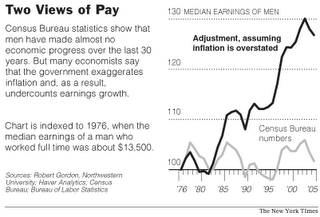Are Living Standards Improving or Not?
 Today's NY Times has a good article in today's (9/20/06) Business Section about living standards, and whether they have been increasing or decreasing over time. One important economic issue is the fact that official consumer price data overstate the actual cost of living, which then understates in the increases in real income (see graph above). One reason for the overstatement pointed out in the article is that new products don't get added to the official basket of 364 items of goods and services until much of the significant price decreases have occurred.
Today's NY Times has a good article in today's (9/20/06) Business Section about living standards, and whether they have been increasing or decreasing over time. One important economic issue is the fact that official consumer price data overstate the actual cost of living, which then understates in the increases in real income (see graph above). One reason for the overstatement pointed out in the article is that new products don't get added to the official basket of 364 items of goods and services until much of the significant price decreases have occurred."But the experts keep fighting over living standards, largely because the single most commonly used measure of well-being — how much money people make — can be very misleading. This is where inflation, the second big issue, comes in.
In the early 1950’s, Toro began selling mass-market snow blowers, which weighed up to 500 pounds and cost at least $150. As far as the Bureau of the Labor Statistics was concerned, however, snow blowers did not exist until 1978. That was the year when the machines began to be counted in the Consumer Price Index, the source of the official inflation rate. By then, the cheapest model sold for about $100.In practical terms, this was an enormous price decline compared with the 1950’s, because incomes had risen enormously over this period. Yet the price index completely missed it and, by doing so, overstated inflation. It counted the rising cost of cars and groceries but not the falling cost of snow blowers.
The cellphone and the air-conditioner also improved middle-class life, and also took years to get into the inflation numbers, by which point their prices had plummeted. Wal-Mart’s effect on prices is another blind spot in the index, which considers something sold at a discount to be lower quality (and, therefore, not truly a bargain) than something sold at full price — even when the items are identical, like a box of Tide or a can of Campbell’s Soup."

0 Comments:
Post a Comment
<< Home